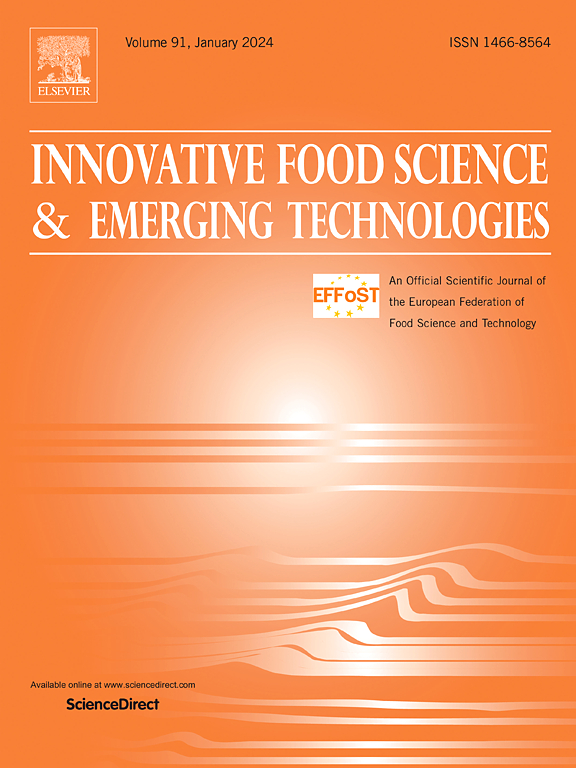采用共晶溶剂和先进的萃取技术,从智利野生木檀、candollei B.和Ugni molinae T.中可持续提取多酚
IF 6.3
1区 农林科学
Q1 FOOD SCIENCE & TECHNOLOGY
Innovative Food Science & Emerging Technologies
Pub Date : 2025-04-04
DOI:10.1016/j.ifset.2025.104017
引用次数: 0
摘要
墨尔塔,原产于智利南部,包括红色墨尔塔(Ugni molinae Turcz)和白色墨尔塔(Ugni candollei Barm),传统上用于民族植物医学,因为它具有抗炎和镇痛的特性,这是由于其高类黄酮和酚酸含量。尽管murta具有潜力,但可持续提取技术——共晶溶剂(ES)、微波辅助提取(MAE)和超声辅助提取(UAE)——对其多酚谱的综合影响仍未被探索。综合分析应量化可提取多酚(EPP)和不可提取多酚(NEPP)。本研究考察了8种ES萃取液对红白murta叶和果实中多酚的萃取效果,优化了萃取液的含水量和料液比。用HPLC-DAD测定,氯化胆碱:1,3-丁二醇(ChCl: 1,3bd),水30%,比例1:10,EPP含量最高。在不同的MAE和UAE条件下,353 K、3 min的MAE获得了最佳的酚类化合物产率,其中叶提取物中以儿茶素为主,果实提取物中以没食子酸为主。NEPP组分主要由不可提取的原花青素组成,占果实和叶片中总多酚的8 - 19%。这些发现建立了一种可持续的方法,用于从murta中获得富含多酚的提取物,并强调了EPP和NEPP组分在增强通过环保技术获得的这些富含抗氧化剂的食品提取物的潜力方面的重要性。本文章由计算机程序翻译,如有差异,请以英文原文为准。
A sustainable approach to obtain polyphenols from Chilean wild murta, Ugni candollei B., and Ugni molinae T., using eutectic solvents and advanced extraction techniques
Murta, native to southern Chile, comprises red murta (Ugni molinae Turcz) and white murta (Ugni candollei Barm), traditionally utilized in ethnobotanical medicine for its anti-inflammatory and analgesic properties attributed to high flavonoid and phenolic acid content. Despite murta's potential, the combined effects of sustainable extraction techniques—eutectic solvents (ES), microwave-assisted extraction (MAE), and ultrasound-assisted extraction (UAE)—on its polyphenol profile remain unexplored. A comprehensive analysis should quantify extractable polyphenols (EPP) and non-extractable polyphenols (NEPP). This study evaluated eight ES mixtures for polyphenol extraction from red and white murta leaves and fruits, optimizing water percentage and feed:solvent ratio. Choline chloride:1,3-butanediol (ChCl:1,3BD) with 30 % water and a 1:10 ratio yielded the highest EPP content, as determined by HPLC-DAD. Among various MAE and UAE conditions tested, MAE at 353 K for 3 min achieved optimal phenolic compound yields, with catechin predominating in leaf extracts and gallic acid in fruit extracts. NEPP fractions, consisting primarily of non-extractable proanthocyanidins, represented 8–19 % of total polyphenols in fruits and leaves. These findings establish a sustainable methodology for obtaining polyphenol-rich extracts from murta and highlight the importance of both EPP and NEPP fractions in enhancing the potential of these antioxidant-enriched food extracts obtained through eco-friendly technologies.
求助全文
通过发布文献求助,成功后即可免费获取论文全文。
去求助
来源期刊
CiteScore
12.00
自引率
6.10%
发文量
259
审稿时长
25 days
期刊介绍:
Innovative Food Science and Emerging Technologies (IFSET) aims to provide the highest quality original contributions and few, mainly upon invitation, reviews on and highly innovative developments in food science and emerging food process technologies. The significance of the results either for the science community or for industrial R&D groups must be specified. Papers submitted must be of highest scientific quality and only those advancing current scientific knowledge and understanding or with technical relevance will be considered.

 求助内容:
求助内容: 应助结果提醒方式:
应助结果提醒方式:


